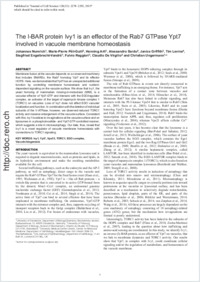The I-BAR protein Ivy1 is an effector of the Rab7 GTPase Ypt7 involved in vacuole membrane homeostasis
- Numrich, Johannes University of Osnabrück, Department of Biology/Chemistry, Biochemistry section, Germany
- Péli-Gulli, Marie-Pierre University of Fribourg, Department of Biology, Division of Biochemistry, Switzerland
- Arlt, Henning University of Osnabrück, Department of Biology/Chemistry, Biochemistry section, Germany
- Sardu, Alessandro University of Fribourg, Department of Biology, Division of Biochemistry, Switzerland
- Griffith, Janice University Medical Centre Utrecht, Center for Molecular Medicine, Department of Cell Biology, The Netherlands
- Levine, Tim UCL Institute of Ophthalmology, Department of Cell Biology, London, UK
- Engelbrecht-Vandré, Siegfried University of Osnabrück, Department of Biology/Chemistry, Biochemistry section, Germany
- Reggiori, Fulvio University Medical Centre Utrecht, Center for Molecular Medicine, Department of Cell Biology, The Netherlands
- De Virgilio, Claudio University of Fribourg, Department of Biology, Division of Biochemistry, Switzerland
- Ungermann, Christian University of Osnabrück, Department of Biology/Chemistry, Biochemistry section, Germany
-
07.01.2015
Published in:
- Journal of Cell Science. - 2015, vol. 128, no. 13, p. 2278–2292
English
Membrane fusion at the vacuole depends on a conserved machinery that includes SNAREs, the Rab7 homolog Ypt7 and its effector HOPS. Here, we demonstrate that Ypt7 has an unexpected additional function by controlling membrane homeostasis and nutrient-dependent signaling on the vacuole surface. We show that Ivy1, the yeast homolog of mammalian missing-in-metastasis (MIM), is a vacuolar effector of Ypt7-GTP and interacts with the EGO/ragulator complex, an activator of the target of rapamycin kinase complex 1 (TORC1) on vacuoles. Loss of Ivy1 does not affect EGO vacuolar localization and function. In combination with the deletion of individual subunits of the V-ATPase, however, we observed reduced TORC1 activity and massive enlargement of the vacuole surface. Consistent with this, Ivy1 localizes to invaginations at the vacuole surface and on liposomes in a phosphoinositide- and Ypt7-GTP-controlled manner, which suggests a role in microautophagy. Our data, thus, reveal that Ivy1 is a novel regulator of vacuole membrane homeostasis with connections to TORC1 signaling.
- Faculty
- Faculté des sciences et de médecine
- Department
- Département de Biologie
- Language
-
- English
- Classification
- Biological sciences
- License
- License undefined
- Identifiers
-
- RERO DOC 257086
- DOI 10.1242/jcs.164905
- Persistent URL
- https://folia.unifr.ch/unifr/documents/304371
Other files
Statistics
Document views: 68
File downloads:
- pel_bpi.pdf: 124
- pel_bpi_sm.pdf: 111

